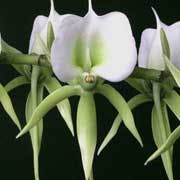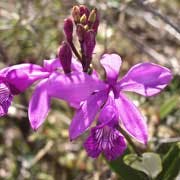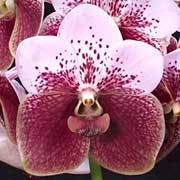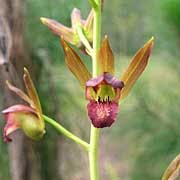E
E- A lack of (Latin prefix).
Earina (EER-ee-nah) A genus of seven species of epiphytes from New Zealand and other Pacific Islands, related to Glomera and other genera seldom seen in cultivation. It was described by Lindley in 1842, the name referring to the species' spring flowering.
ebracteatus, -a, -um (ee-brak-tee-AY-tus) Without bracts; ebracteate.
Eburneum: Angraecum eburneum has an ivory-white lip.

eburneus, -a, -um (ee-BURN-ee-us) Ivory-like; ivory-white.
ecalcarate (ee-KAL-kar-ayt) Without calcar or spur.
ecallose (ee-KAL-lohz) Without a callus; lacking any protuberance.
echinatus, -a, -um (ek-in-AY-tus) Furnished with prickles or bristles; spiny; echinate.
echinocarpus, -a, -um A spiny or echinate fruit.
ecology (ih-KOL-uh-jee) That branch of biology that deals with the mutual interaction between organisms and their environment.
ecornutus, -a, -um (ee-kor-NEW-tus) Without horns; ecornute.
ecostate (ee-KOS-tayt) Without ribs.
ecotype (EE-ko-type) Plants of a genetically stabilized modification to a variant ecology such as dwarfed individuals from a relatively more xeromorphic habitat.
edaphic (ee-DAFF-ik) Relating to soil and topography, rather than climate.
edentate (ee-DEN-tayt) Without teeth.
effusus, -a, -um (ef-FEW-sus) Loosely spreading; very diffuse; effuse.
eglandulose (ee-GLAND-yew-lohz) Without glands.
elatus, -a, -um (e-LAY-tus) Tall; taller than the parts or organs of the plant would lead us to expect, or tall in comparison with its near allies.
elatior (el-AY-tee-or) Taller.
elegans (EL-e-ganz) Very choice and attractive; worthy of being chosen; elegant.
Elleanthus (el-lee-AN-thus) A genus of 115 species of tropical American epiphytic orchids, vegetatively similar to its nearest relative, Sobralia, but bearing a number of small flowers in a head or short raceme. It was described by the Czech botanist Presl in 1827, the name presumably dedicated to Helle or Helena.
ellipsoid (ih-LIP-soyd) An elongate solid, elliptical in all sections along the transverse axis and circular in cross-section.
elliptic (ih-LIP-tick) An oval, equally narrowed to rounded ends.
elongate (ee-LONG-ayt) Drawn out in length; lengthened.
emarginatus, -a, -um (ee-mar-jin-AY-tus) Having a shallow notch at the apex; emarginate.
embryo (em-BREE-oh) The zygote or developing plantlet in the seed.
Embreea (em-BREE-ah) A monotypic genus, a segregate of Stanhopea, native to Colombia and Ecuador. Dodson established the genus in 1980, naming it in honor of Alvin Embree, one of Dodson's supporters.
Encyclia (en-SIK-lee-ah) A genus of about 240 Neotropical species previously included in a broadly defined Epidendrum, sometimes known in horticulture as bulbous epidendrums. Hooker described the genus in 1828, but it wasn't until studies by Dressler in 1961 that the genus was truly established.
endemic (en-DEM-ik) Native to a particular region, as a country or an island, and not found elsewhere.
endocarp (EN-doh-carp) The inner layer of the wall of a ripened fruit.
endogenous (en-DOJ-uh-nuhs) Growing or developing from or on the inside.
endosperm (EN-do-spurm) Starch or other food outside or around the embryo; albumen; nutritive matter in seed plant ovules; absent in most orchids.
ensatus, -a, -um (en-SAY-tus) Sword-shaped.
ensifolius, -a, -um (en-si-FOH-lee-us) Having sword-shaped leaves.
ensiformis, -e (en-si-FORM-is) Straight, with a sharp point like a sword; ensiform.
entire (en-TYE-er) In reference to the floral segments and leafblade, having the margin continuous, not broken with teeth or serrations.
entomophilus, -a, -um (ent-oh-MOFF-ill-us) Insect-loving; a specific name applied to certain plants that attract insects; entomophilous.
entomophily (en-toh-MOFF-ill-ee) Pollination through the agency of insects.
environment (en-vahy-ern-muhnt) The aggregate of surrounding things, conditions and influences.
ephemeral (e-FEM-er-al) Lasting for only a brief period; transitory.
epi- A Greek prefix signifying "on" or "upon."
epicalyx (ep-ee-KAY-licks) A series of bracts, resembling or near the calyx
Epicattleya (ep-i-CAT-lee-ah) A hybrid genus between Epidendrum and Cattleya created in 1888. Most Epicattleya hybrids are actually Catyclia (Encyclia x Cattleya) hybrids and have now been transferred to that genus.
epicarp (EP-i-karp) The outer layer or surface of the pericarp, as the rind or peel of some fruits.
Epichile: Stanhopea oculata showing the epichile.

epichile (EP-i-kyle) The terminal part of the jointed lip of some orchids such as Stanhopea.
Epidanthus (ep-ee-DAN-thus) There are three epiphytic species in this genus ranging from Mexico to Panama. Williams described the genus in 1940. The name was derived partially from the Greek and means flowers like Epidendrum.
epidendroides (e-pi-den-DROY-deez) Resembling an Epidendrum.
Epidendrum (eh-pi-DEN-drum) A genus of 800 species of tropical American orchids closely related to Laelia and Cattleya, the generic name having been used by Linnaeus in 1753 in reference to the epiphytic habit of the plants and originally including a number of concepts now referred to different genera of epiphytic orchids.
epidermis (ep-ee-DER-miss) The outermost layer of cellular tissue enveloping the entire plant body, functioning as a protective covering and as a control against loss of water.
epigaeus, -a, -um (eh-pi-JEE-us) Growing close to the ground; epigeous.
Epigeneium (eh-pi-JEE-nee-um) A genus of 12 species of epiphytic orchids from the Asiatic tropics, related to Dendrobium and formerly placed in either Dendrobium or Sarcopodium. Established by French botanist Gagnepain in 1932, the name means "upon the chin" and refers to the position of the petals and lateral sepals on the column foot.
epigynous (ih-PIJ-uh-nuhs) Growing on top of the ovary.
Epipactis (eh-pi-PAK-tis) A genus of 21 species of circumboreal terrestrial orchids related to Cephalanthera, established in 1800 by Swartz, who employed an ancient name originally used by Theophrastus (370?285 BC)
epiparasitic (ep-i-pair-ah-SIT-ick) Said of organisms such as saprophytic orchids that are not primary saprophytes but instead live as parasites upon wholly saprophytic fungal symbionts.
epiphyte (EP-i-fite) A plant that naturally grows on another plant or other means of support above the earth's soil but, in contrast to parasitic, deriving its needed moisture from the air.
epiphytic (ep-i-FIT-ik) Pertaining to an epiphyte; having the character of an epiphyte.
Epistephium: Epistephium hernandii photographed in Venezuela's Gran Sabana.

Epistephium (eh-pi-STEEF-ee-um) A genus of 14 species of terrestrial orchids from South America (chiefly Brazil) with brilliant purple Cattleya-like flowers, related to Sobralia and to Vanilla. It was described by Humboldt, Bonpland and Kunth in 1822, from the Greek meaning garlanded, referring to the crown-like swelling at the tip of the ovary.
epseudobulbous (ee-soo-doh-BUL-bus) Without pseudobulbs.
equalis, -e (ee-KWAY-lis) Equal.
equestris, -e (ee-KWES-tris) Knightly, courteous, very handsome; pertaining to a horse, or like the rider of a horse.
Equitant: Psygmorchis pusilla has equitant foliage.

equitant (EK-kwi-tant) Said of conduplicate leaves that overlap each other in two ranks, as in Oberonia, Psygmorchis and Tolumnia (equitant oncidiums).
erectus, -a, -um (er-REK-tus) Upright; erect.
Eria (EAR-ee-a) A genus of 500 epiphytic species of Asiatic orchids closely related to Dendrobium, described in 1825 by Lindley, the name alluding to the woolly outer surface of the sepals and petals.
ericoides (e-ri-KOY-deez) Resembling Erica or heather.
erinaceus, -a, -um (e-rin-AY-see-us) Resembling a hedgehog; spiny; erinaceous.
Eriopsis (ear-ee-OP-siss) A genus of four species of tropical American epiphytic orchids with close affinity to Acineta and Coeliopsis, described by Lindley in 1847. The name is derived from the Greek, meaning resembling Eria, a genus to which it is but distantly related.
erosus, -a,-um (ee-ROH-sus) Jagged, as if gnawed; having a ragged edge; erose.
erostrate (e-ROSS-trayt) Without a beak.
erubescens (e-roo-BESS-enz) Blushing; growing rosy red.
Erycina (err-ee-SEE-nah) The two epiphytic species in this genus are found in Mexico. Lindley described the genus in 1853, naming it in honor of Erycina, the Aphrodite of Mt. Eryx, in Sicily.
Erythrodes (err-i-THROH-deez) A genus of 60 species of terrestrial orchids found in the tropics and subtropics of both hemispheres related to Goodyera and described by Blume in 1825, the name referring to the reddish color of the flowers of many of the species.
erythrocarpus, -a, -um (e-ri-thro-KAR-pus) Having red fruit.
esculentus, -a, -um (es-kew-LEN-tus) Edible; related to eating.
estriatus, -a, -um (es-tri-AY-tus) Without stripes.
Esmeralda (es-mer-ALL-duh) H.G. Reichenbach described this genus in 1874, using the Greek word meaning "emerald green," possibly a reference to the deep green foliage. There are two species growing either terrestrially or lithophytically that are native from the Himalayas east to southern China.
ethylene (ETH-ill-een) A gas that acts as a hormone signaling numerous physiologic changes including flower senescence.
etiolation (ee-ti-o-LAY-shun) Effect on green plant from loss of chlorophyll through exclusion of light, the normally green tissue becoming white or yellow by unmasking of carotenoids within the chloroplasts.
Euanthe: Euanthe sanderiana is the single species in the genus, now classified as a Vanda.

Euanthe (yew-AN-thee) A monotypic genus established by Schlechter in 1914 to accommodate the species most widely accepted as Vanda sanderiana, the distinction from Vanda being based on recondite characters in the structure of the lip.
Eulophia: Eulophia alta can be found on several continents.

Eulophia (yew-LOH-fee-ah) A genus of 200 species of terrestrial orchids related to Cyrtopodium, widespread throughout the Old World tropics with a single species in the Americas. Described in 1823 by Robert Brown, the name refers to the crest on the lip.
Eulophidium (yew-loh-FID-ee-um) A later name for a genus of chiefly terrestrial orchids from tropical Africa and Madagascar (with one species throughout the Americas), now placed in Oeceoclades. Described by Pfitzer in 1888, the name is a diminutive for Eulophia and refers to its presumed relationship with that genus.
Eulophiella (yew-loh-fee-EL-lah) A small genus of epiphytic orchids from the island of Madagascar, somewhat allied with Cyrtopodium. Described by Rolfe in 1891, the name is a diminutive of Eulophia.
europaeus, -a, -um (yoor-o-PEE-us) European.
evanescent (ev-a-NESS-sent) Short-lived; not lasting for a long period.
evaporative cooler (ih-vap-ruh-tive kool-er) A mechanism that cools air by the evaporation of water. See desert cooler.
evectus, -a, -um (e-VEK-tus) Exalted, proud, stately.
evergreen (eh-ver-green) Retaining green foliage all the year, as certain species of Dendrobium, in contrast to those that are deciduous.
evertus, -a, -um (ee-VERT-us) Turned inside out.
exaltatus, -a, -um (eks-all-TAY-tus) Very tall; lofty; exalted.
exasperatus, -a, -um (eks-as-per-AY-tus) Roughened; having a rough surface.
excavatus, -a, -um (eks-kav-AY-tus) Hollowed out.
excellens (eks-SELL-enz) Excelling; excellent.
excelsior (ex-SELL-see-or) A shaved-wood product used to provide surface area in evaporative coolers.
excelsus, -a, -um (eks-SELL-sus) Tall.
excentric (ik-SEN-trik) One sided or off center.
excisus, -a, -um (eks-SYE-sus) Cutaway; cut out; excise.
excrescences (eks-KRESS-en-ses) Small warty outgrowths.
excurrent (ik-SKUR-uhnt) Said of a leaf base that extends beyond the margin of the blade.
exfoliating (ex-FOL-ee-ayt-ing) Peeling off in thin layers.
exiguus, -a, -um (eks-IG-yew-us) Very little; meager; poor.
eximius, -a, -um (eks-IM-ee-us) Out of the ordinary; distinguished.
exine (EKS-ine) The outer layer of a pollen grain.
exocary (EKS-oh-kary) The outer layer of the pericarp.
exotic (ek-ZOTT-ik) Not native, foreign.
expansus, -a, -um (eks-PAN-sus) Expanded.
explant (EKS-plant) A small piece of tissue removed from a donor plant and placed in tissue culture.
explante (EKS-plant-ay) Lying flat.
exserted (ek-SER-ted) Projecting beyond a common point.
exsiccated (EK-sik-kay-ted) Dried; having the moisture removed.
extrorse (eks-TRORS) Looking or facing outward.
exudans (EKS-yew-danz) Exuding.
eye The incipient bud of a vegetative growth, particularly in sympodial orchids.









